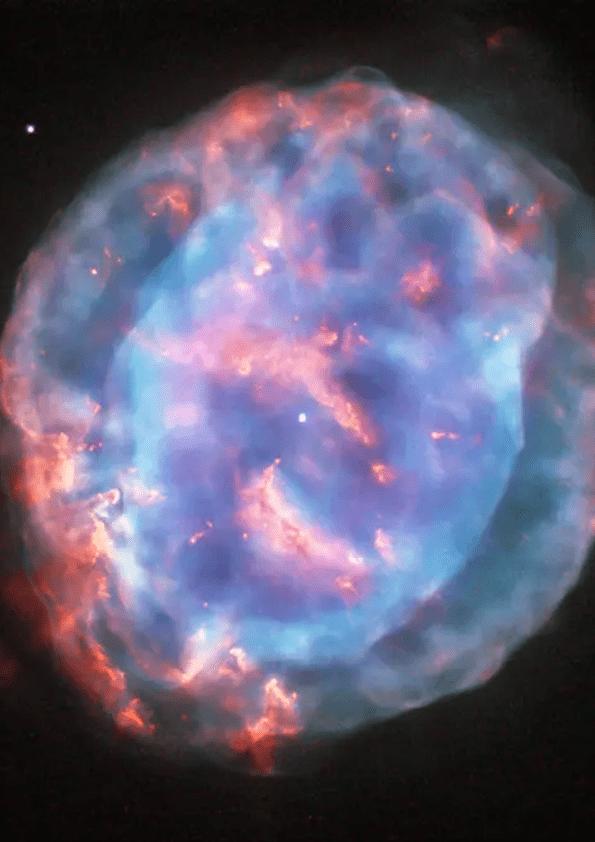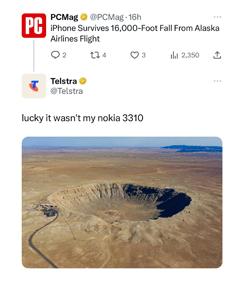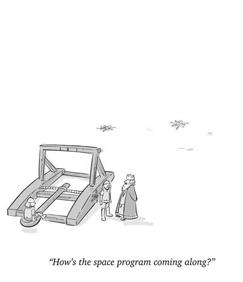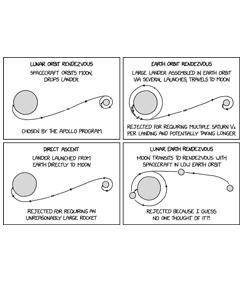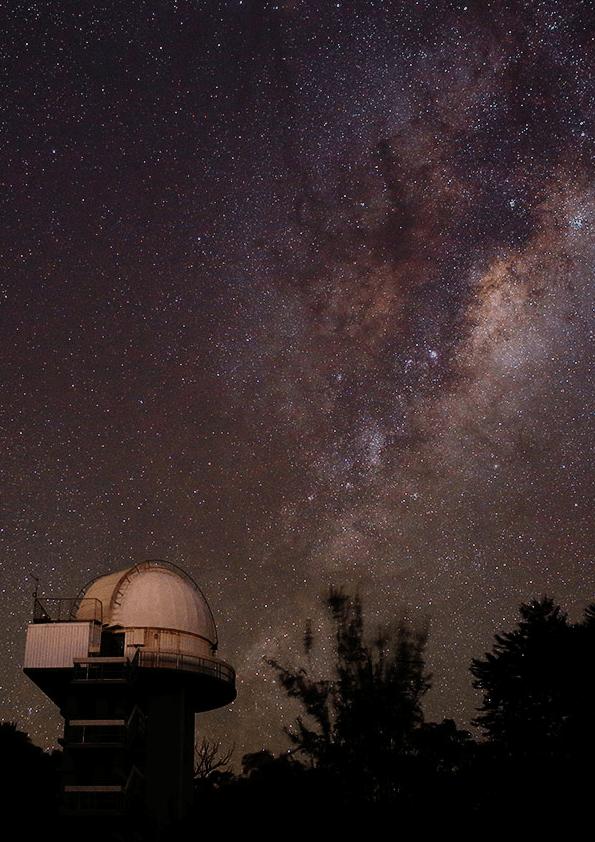Countdown to Cosmic Cataclysm
A binary system is bracing itself for a rare nova explosion
The Big Vacuum Cleaners
Answering questions about black holes and other great myths about them

A binary system is bracing itself for a rare nova explosion
Answering questions about black holes and other great myths about them
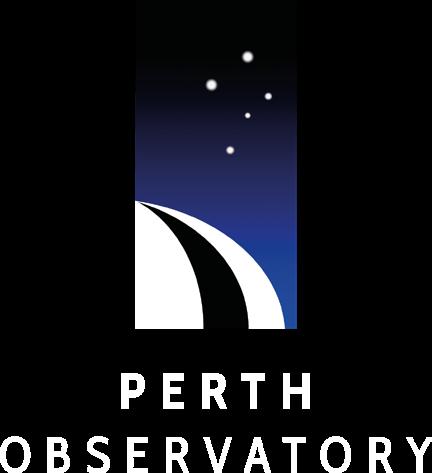
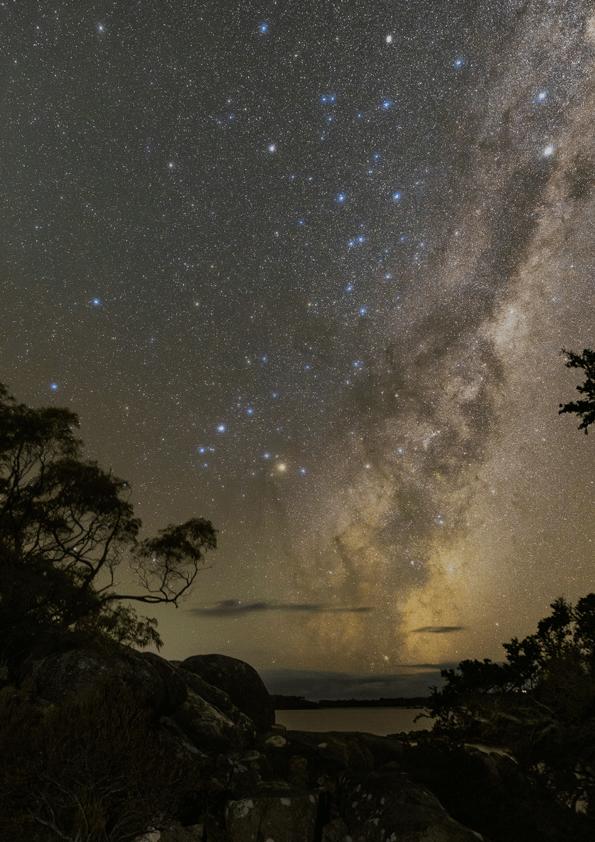
We’re having a rethink on the true colours of our distant Ice Giants Uranus and Neptune
Our Julie Matthews sits down and interviews the POVG Gardening Gals Jo and Sue
Do you have a passion for space and astronomy? Want to take that passion to the next level?
The Perth Observatory has organised a 5-week astronomy course so you can improve your knowledge of our universe. Each week we’ll cover a different topic. We’ll also have a Q&A session with tea and coffee before heading up to the telescopes. The course includes handouts of the relevant data, diagrams, and references.
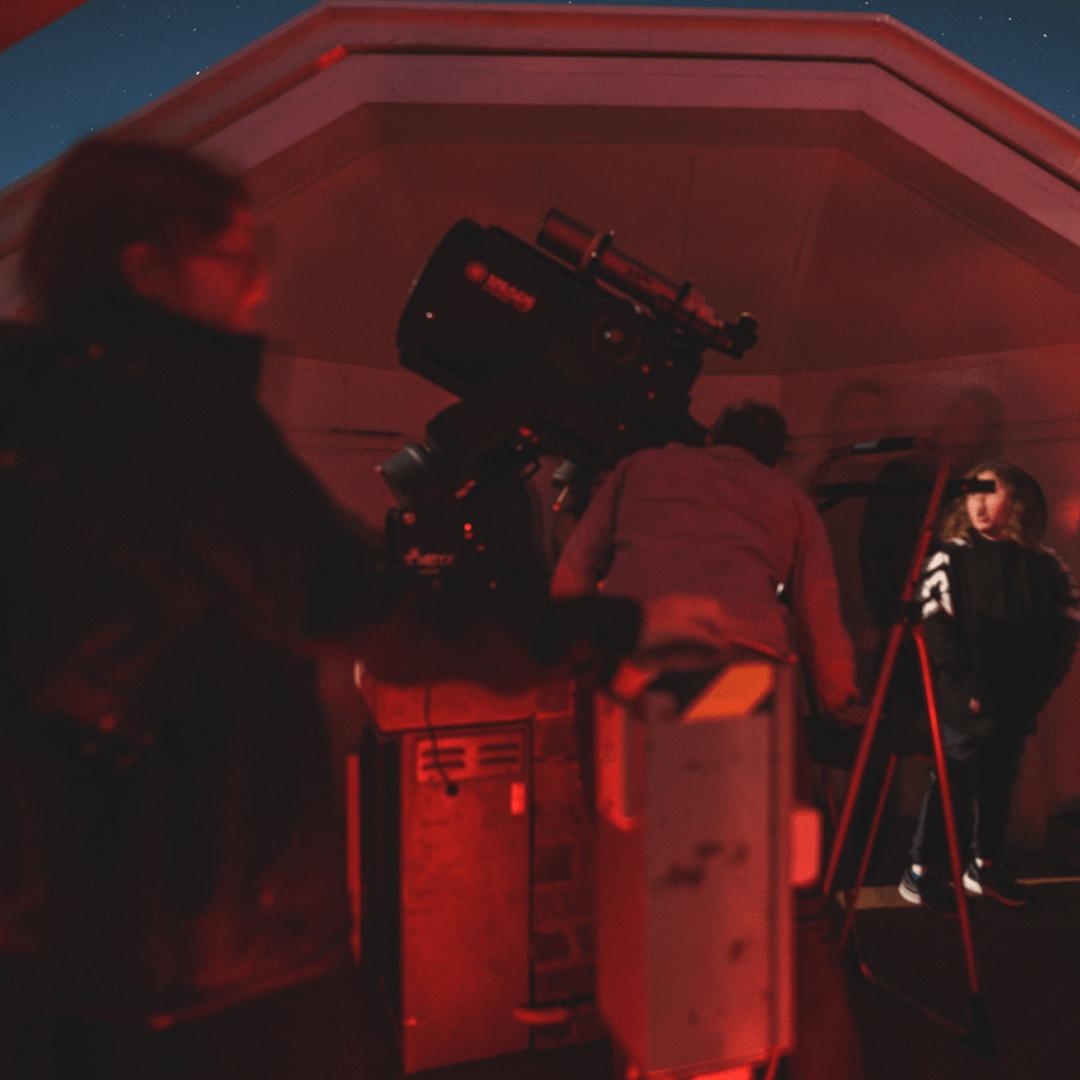
Jenny Gull, our presenter for this course has been part of the Perth Observatory Volunteer Group and has worked in the STEM field for decades. Upon completion of the 5-week course, each participant will receive a special Perth Observatory certificate.

The history of astronomy is a history of receding horizons.
 - Edwin Hubble, Astronomer
- Edwin Hubble, Astronomer

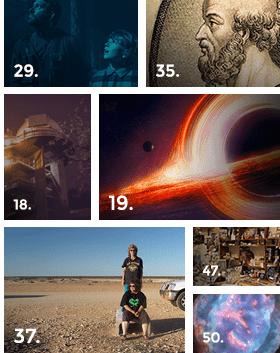
Editorial
Matt Woods Editor Contributors
Michelle Ashley-Emile, Godfrey Barrett-Lennard, Amber Berriman, Mary Hughes, Louise Kaestner, Ronny Kaplanian, Jerry Lodriguss, Roger Groom, Julie Matthews, & Matt Woods
This year has been very busy for the Perth Observatory, bustling with activities that have captivated the minds and imaginations of astronomy enthusiasts. From our highly attended night sky tours to engaging workshops in painting and astrophotography, our calendar has been brimming with events.
But that’s just the beginning. We’ve hosted a series of special events that have drawn crowds eager to delve into the wonders of the cosmos. From the Intro to the Stars Festival in January, where 400 people learned about astronomy and the Perth Observatory, to the Hills Symphony Orchestra Sci-Fi Concert in February, enchanting 200 attendees with melodies from Sci-Fi shows and movies. March brought another highlight with our Summer Lecture. Ourur volunteer, Dr Adele Goodwin captivated an audience of 200 with fascinating insights into black holes.
In April, our Fairy Afternoon Tea charmed 130 guests with a lovely autumn afternoon at the Observatory, and 122 people joined us to celebrate Yuri’s Night event on the 12th, where we held a screening of the acclaimed 2019 documentary Apollo 11 and a Q/A session with the Archive Producer for the film. Additionally, we participate in the Kalamunda Show on the 12th and 13th, bringing astronomy closer to our community in the Perth Hills. Looking ahead to May, we’ll be part of the Bickley Harvest Festival, offering guided tours and engaging activities for children on the 4th and 5th
At the Observatory, we’re taking the opportunity to conduct major maintenance on our Millennium Dome building. While the dome undergoes rejuvenation, it’ll emerge gleaming and quieter than ever before. On the research front, our installation of 16 Global Meteor Network cameras, generously funded by Inspiring Western Australia, marks a significant milestones. These cameras, dispersed across WA, are now contributing invaluable data for a range of scientific endeavours, from tracking meteors to safeguarding satellites and astronauts in orbit.
In this edition of Galaxia Magazine, we’re thrilled to present an array of captivating articles from our volunteers, delving into topics ranging from black holes to the true colours of Uranus and Neptune. Join us as we explore the wonders of the universe, review a sci-fi flick, and guide you through the celestial highlights of May, and June.
Matt Woods Editor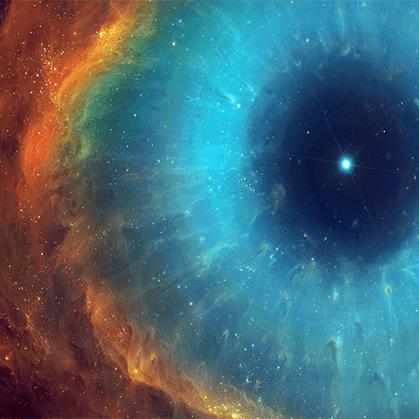
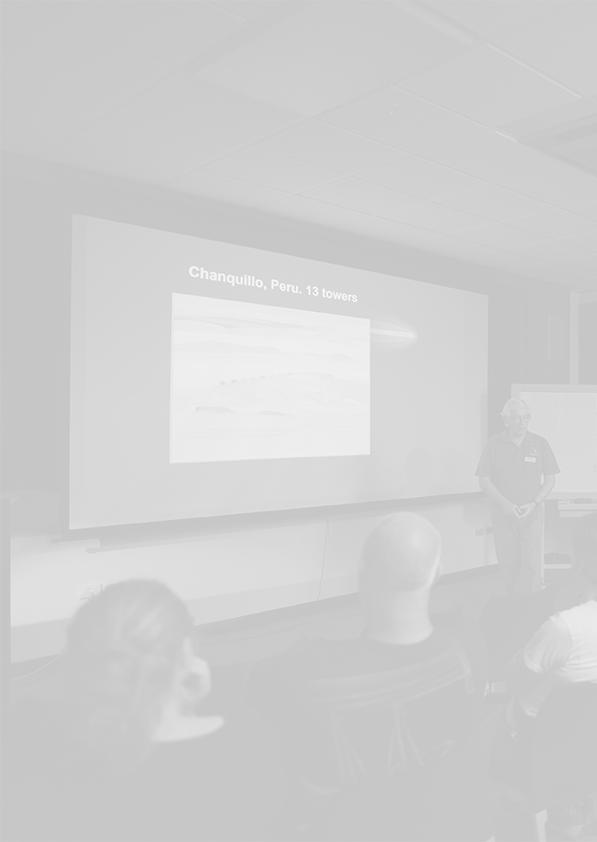
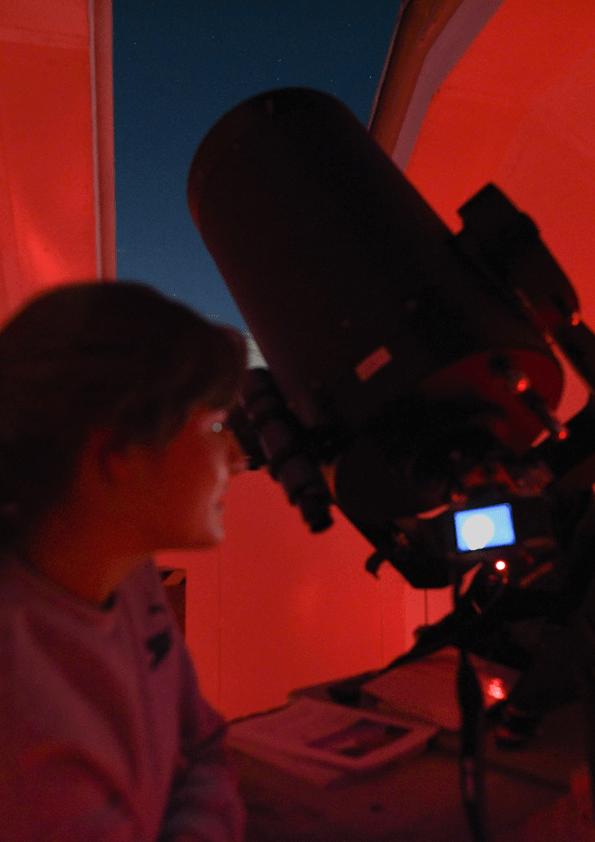

Bickley Harvest Festival Tours
Time: 10 am - 4 pm
Price: $50 for families (2 adults and up to 3 children), $20 per adult, $15 per concession, $10 per child (12-17), and free for children under 12
The Observatory will be open during the festival, giving you a chance to explore our rich history and the wonders of the universe. Our knowledgeable guides will take you on a journey through time with guided tours of the Observatory and provide kids activities.
Astronomy 102 Course
Time: 7 pm - 8:30 pm
Price: $300 per person
Are you fascinated by the vast expanse of space and the mysteries of our universe, and want to learn more about it? Well, now is the perfect opportunity to discover more about our amazing cosmos!
Each week of this 5 week course, we’ll delve deeper into a different aspect of the universe, with engaging presentations and interactive Q&A sessions. You’ll also have the chance to get hands-on experience with telescopes and equipment to observe the night sky.
Lunar Photography Workshop
Time: 7 pm - 10 pm
Price: $120 per person
This promises to be a fun relaxed evening of photographing the Moon on some fantastic telescopes using your camera.
Using a combination of Astrophotography Australia telescope and equipment, and the Perth Observatory telescopes, to take awesome photographs of the moon, and at much higher magnification.
Towel Day Night Tour
Time: 7:30 to 9 pm
Price: $55 per adult, $40 per concession and $30 per child
Join us on the 25th of May to celebrate Towel Day, an annual tribute to the author Douglas Adams and his beloved series, The Hitchhiker’s Guide to the Galaxy. Bring your towel and come to the Perth Observatory for an unforgettable night.
Our volunteers will be ready to take you on a grand tour of the Southern Hemisphere’s sky with a wide range of targets including nebulae, and enormous star clusters.
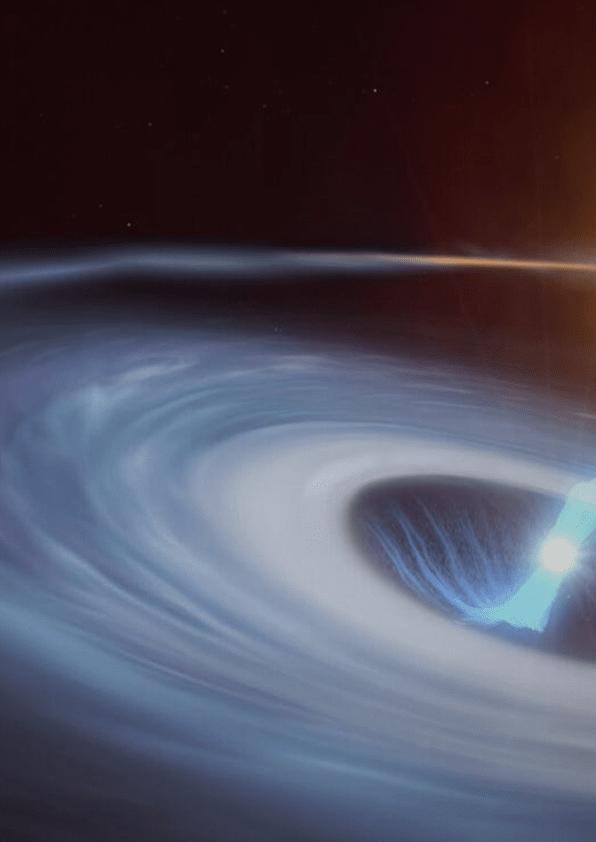
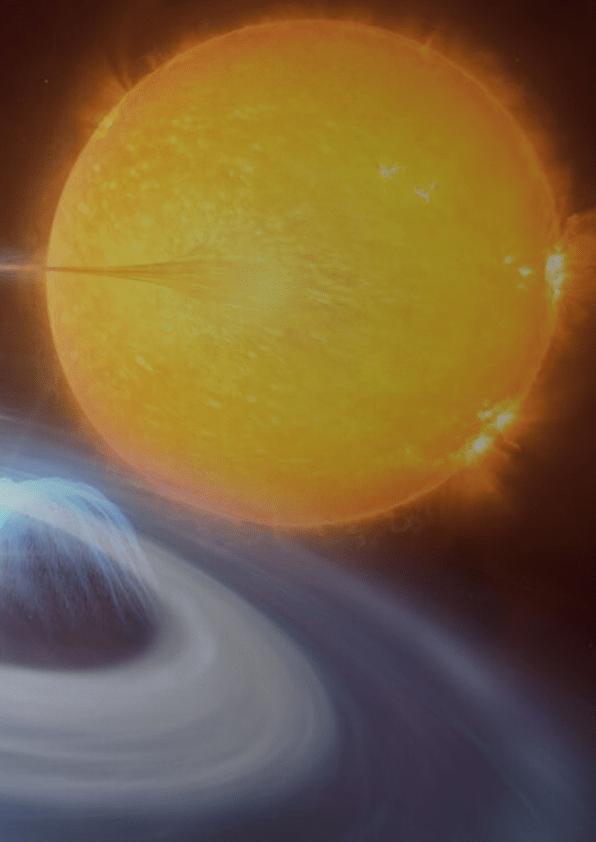
Adistant Corona Borealis binary system which contains one white dwarf star, and one red giant star has been busy gearing up for a spectacular nova explosion. Located 3,000 light years from Earth, the white dwarf star which is called T Coronae Borealis (T CrB for short) is on the verge of what Nasa says will be a once-in-a-lifetime nova eruption. The rare cosmic event is expected to take place sometime before September 2024 and when it occurs it will likely be visible to the naked eye.
The reason this is going to happen is that white dwarfs have masses like the Sun, but have a diameter around a hundred times smaller, making them comparable in size to Earth. That high mass but relatively small size makes a white dwarf’s gravity especially strong. As the red giant in the binary system ejects gas into space, the white dwarf’s gravity pulls that gas onto its surface, doing so for years and years.
Most of this gas will be hydrogen, and when too much hydrogen reaches the surface of the incredibly hot white dwarf, it rapidly ignites, creating a large thermonuclear explosion on the surface of the star.
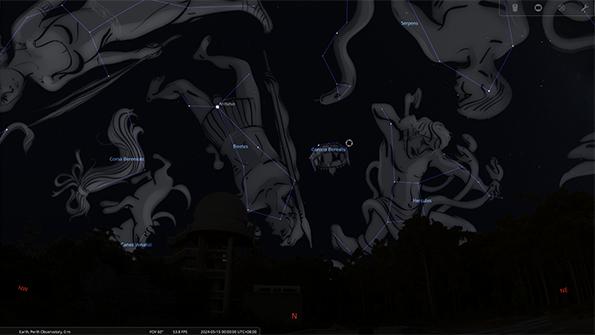
If this does occur between now and September everyone will be able to see it around the world. The binary system isn’t normally visible to the naked eye at magnitude +10, but this nova event is expected to get to magnitude +2 which places the binary system into the top 50 stars and as bright as the planet Mars. It’ll be bright for a few days making it viewable to the naked eye, but it could very well last more than a week before dimming again.
Like Supernova they can temporarily outshine all other stars in their galaxy, but they’re not as powerful as supernovae, they can release energy equivalent to 100,000 times our sun’s output. What makes T CrB very important is that it’s a recurrent nova. This recurrent nova is a nova that periodically blows its top, and there are about 10 novae that are known as “recurrent novae”. In most cases for novae, we have no idea when nova will occur.
Astronomers know T CrB is going to erupt soon due to both mathematical calculations and visible evidence. The last time T CrB experienced a nova was in 1946, 78 years ago. Astronomers also know that before it goes nova it dims for about a year, and this white dwarf started dimming back in March 2023, so that’s why the thinking is it’s going to go nova between now and the end of September.
Lots of nova have been discovered, but most haven’t been known to recur, or they go such long periods without recurring that we don’t know when they will again. The time for a repeat performance of a nova can be anything between one year and as much as millions of years which makes this white dwarf very important to study.
Novae play an important role in enriching the universe with heavy elements and help astronomers study stellar evolution and nucleosynthesis processes. They can also help astronomers understand the mass transfer that takes place between stars in binary systems and the thermonuclear explosions that result when the white dwarf goes nova.
To see the nova display when it does erupt, from the Southern Hemisphere you should look north for the constellation Corona Borealis, or the Northern Crown, a small, semicircular arc near the constellations of Boötes and Hercules. That’s where it will appear as a ‘new’ bright star.

In clear-night darkness stars blaze forth, single and in densebright galaxy clus-ters, over all the visible hemisphere, uncountable one by one. ‘Dark matter’ be-yond our ken, known of only by its gravitation, evidently fills much of space. Great telescopes, radio as well as light, show no spatial boundary, if there is one, to the universe we occupy. We live on our earthbounded world scarce able to imagine a reality with no edges.
Our universe evidently sprang into being from a tiny point - what lay around that point and started its spreading vastness? Are there other universes? Will this one shrink and end eventually? Astronomers infer that time and space are one, but how does this work - or only in math equations?
Our brains are evolved enough to imagine more intelligent beings capable of dis-cerning what we cannot. We live with ‘blinkers’, native and acquired, though wise seekers, like Galileo, see beyond some we acquired. The vast complexity of the human brain has limits, although invention may lead on to the construction of non-biological beings with ranging intelligence past our seeing.
From searching the starry universe’s working various secrets revealed, with more to follow. Yet human brains have their own limitation and higher-order beings log-ically would bring understandings beyond current imagination.
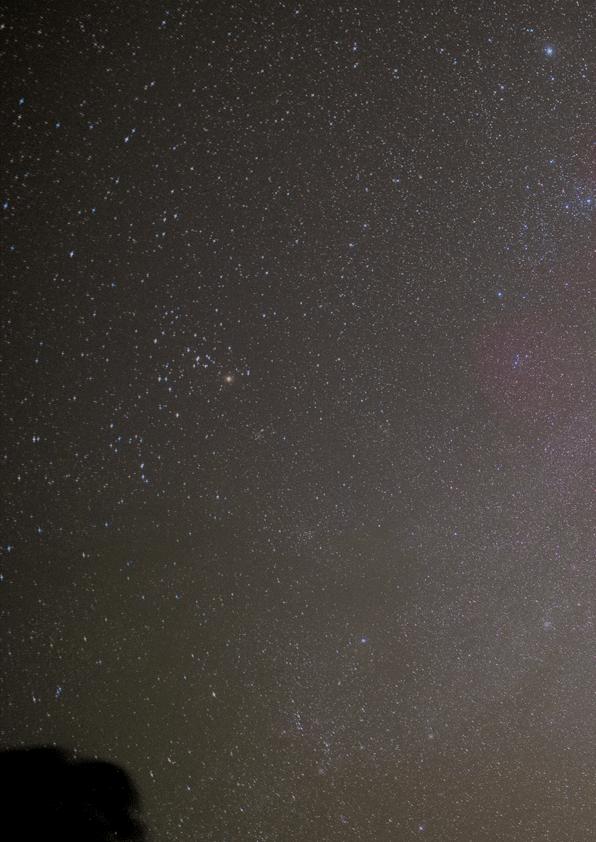
Image Credit: Matt Woods
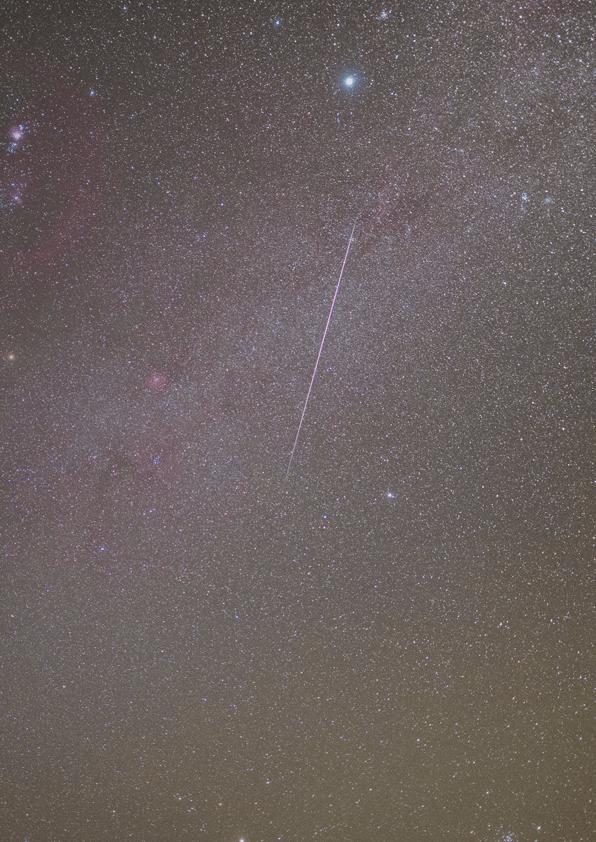
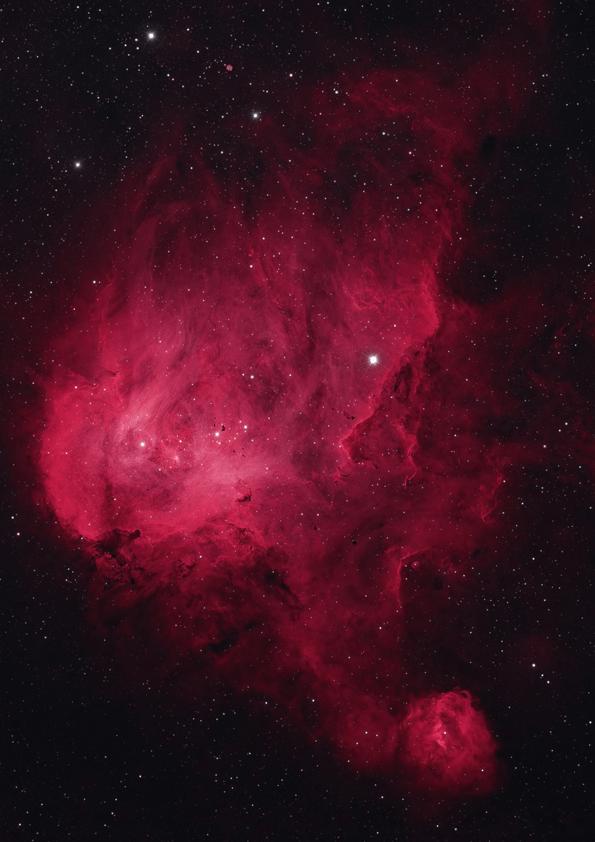

Looking to volunteer and make a difference in the lives of primary school children? If you have free time during the day and a passion for learning about space and our solar system, we invite you to join our School Day Tours Team as a volunteer!
As a member of our team, you will have the opportunity to share your knowledge and enthusiasm with young students while learning from experienced educators. No prior experience is necessary, as we provide all the training you need.
If you enjoy working with children, this could be the perfect opportunity for you! All you need to bring is your enthusiasm, a friendly demeanour, and the ability to communicate with children.
To learn more about how you can get involved, click below and let’s start making a difference in the lives of young students today.
Looking for a unique gift to recognise a special family member or friend? Look no further than our star adoption program! Our program allows you to adopt a star between magnitudes -1 and 7.9 in the Southern Hemisphere, visible to the naked eye or in binoculars.
Each star adoption package includes a certificate with the star’s name and coordinates, as well as the duration and purpose of the adoption. Plus, you and up to three guests can enjoy a private star viewing night within 12 months of the adoption, where you’ll get to see your chosen star and other seasonal objects. We’ll also provide you with a planisphere and star charts, so you can continue to enjoy your star long after your viewing night.
Please note that while we don’t offer international naming rights for stars, the income from our program goes towards supporting the Perth Observatory’s not-for-profit public outreach program. Adopt a star today and give the gift of wonder and discovery!

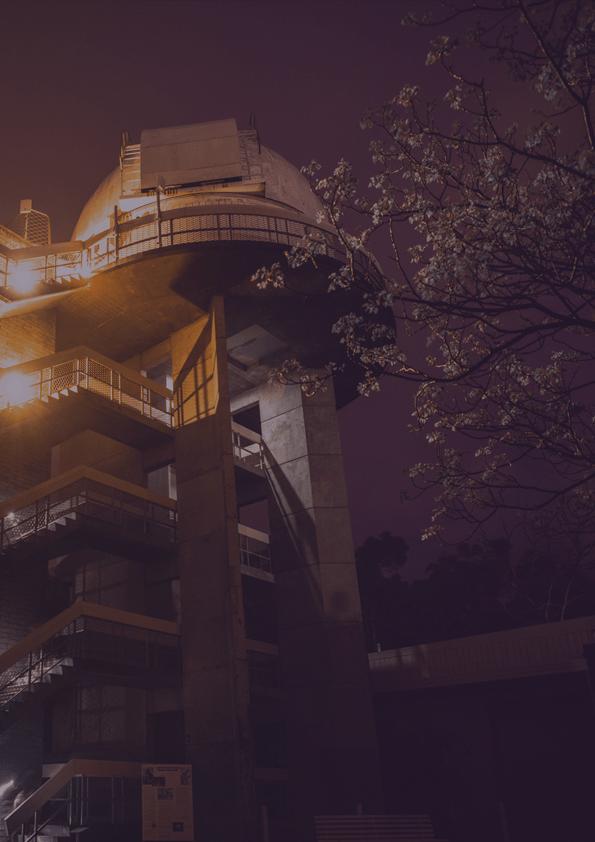
If you’re looking for a good thrill. Do a short trip up to Perth Hills.
There is the Perth Observatory, with a huge historic story.
A telescope: the Astrograph, there a scene turned to a laugh.
Perth wanted in on a great deal. To take part in the Carte du Ceil.
And to chart our southern night sky, photographing Halley’s fly-by.
Calver and its cavalry, proved Einstein right, as you will see.
Up north, it saw an eclipse, along with the Indigenous.
It shows gravity bends the light, confirming that Albert was right.
Lowell, Mars, rings of Uranus, and you think, “You’re playing us”.
The Lowell scope could see so far, as George passed in front of a star.
Two bodies fell into a line. Shadows blocked out the star’s shine.
They found that Uranus had rings. Another planet wearing bling.
That was not Lowell’s only job. Close by, there is a small red blob.
Mar’s the planet, has its dust storms. Harsh for equipment to perform.
They want to know when it is safe, so, the rockets won’t be the waifs.
In the foyer; a telescope. Keeps the time right, we all do hope.
Meridian uses small webs, tracking stars as they flow and ebb.
North to south as it keeps the time, the scope still sits in its prime.
There is more to see way up here. In the Hills where the sky is near.
Volunteers, they power the place, as they bring to you the skies grace.
Ever wondered about the great whirlpool of the universe? Can we travel through them? Will they suck us all in and kill us? What exactly is “spaghettification”? Let’s dive into one of astronomy’s greatest mysteries –Black holes.
Let’s start where all good beginnings do: What; What exactly is a black hole? A black hole in the simplest terms is a small object (in terms of diameter) in comparison to its mass. In fact, if we had a black hole around 1cm in diameter it would theoretically have the same amount of mass as the Earth. For those who don’t know off the top of your head, it is roughly 3.34 x 1024 kgs. Hence because of this huge mass that a black hole has, it always also has a colossal gravity.
*There is a type of black hole I will be discussing quite a bit in the following so here is a simple explanation. Supermassive black holes are black holes that have a mass of around hundreds of thousands to billions greater than the mass of the Sun.
This leads us to myth number 1:
holes suck everything in around them
I’ve always said black holes have such a terrible reputation for being the ‘monsters’ of the universe. The main fault for this is the incredibly popular science fiction genre movies that took creative liberties. So here are some facts.
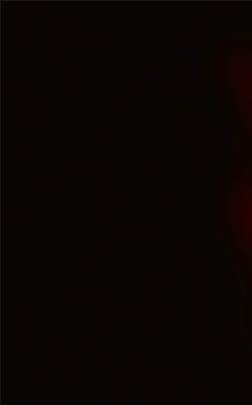
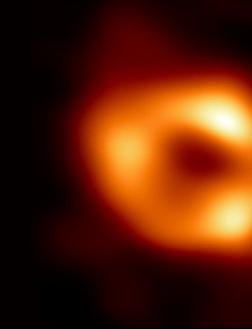
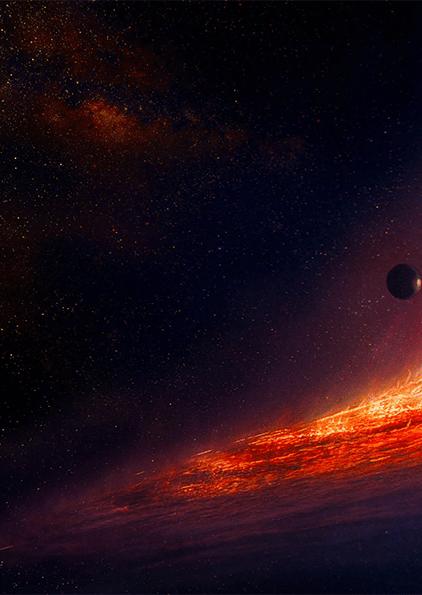


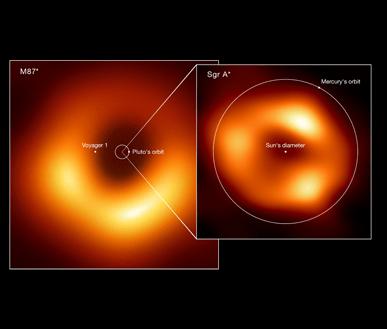

Black holes are not the vacuum cleaners of the universe. Due to their enormous gravity, black holes naturally attract objects around them, stars, planets etc. Some are even massive enough to centre themselves into galaxies such as Sagittarius A, the black hole at the centre of the Milky Way. However, these objects are not immediately ‘sucked in,’ no no, they similarly to us around the sun, begin an orbit around the black hole. Sure, things happen to get close but it’s not the malice of the black hole that causes this, simply the object in the wrong place at the wrong time. Eventually, the object will go past the point of no return called the ‘event horizon.’
This leads to myth number 2:
We can travel through blackholes to get to another point in the universe (i.e., wormholes)
I blame this one entirely on Star Trek (thanks Gene). However, there isn’t quite as simple of an answer as myth one. The answer is maybe, eventually, not in our lifetime but perhaps we could figure out a way. Currently, the answer is no, we cannot travel through black holes to get to another point in the universe. Instead of experiencing a lightning-fast, comfortable cushy ride on the celestial train, you’ll be in for an unbelievably bad time if you fall into a black hole.
So, imagine you pass the event horizon, what’s next? If you fall feet first, your feet would be accelerated super-fast toward the centre, much quicker than your head. This means you will be stretched out as far as you can possibly go lengthwise (head to toes), to compensate for this your body width-wise will become a lot thinner. Similar to spaghetti, hence the scientific term ‘spaghettification.’
So no do not try this diet hack at home.
Interestingly enough, due to the time dilation caused by the black hole’s mass, you would witness millions of years within a matter of milliseconds. There is also speculation that you might witness the heat death of the universe while you are being turned into my sister’s favourite dish.
Time dilation, however, is a topic for another occasion and when I have 100 pages to spare.
This leads us to Myth 3:
Black holes are the key to time travel.
This one again is partially true.
In part, we can go forward in time. Simply put, due to the mass of the black hole time speeds up the closer you get to the black hole as talked about above. If you don’t fall in and somehow you manage to escape the force of gravity you will have time travelled! However, there is no way to return, so you can theoretically time travel futuristically but not backwards.
Myth number 4:
All stars become black holes.
This one, unlike the last, is false. The life cycle of stars is a simple ideal if you know the mass of the star you want to observe. All stars will begin as a stellar nebula, which is a lot of hydrogen gas and dust. Eventually, gravity takes hold and ‘compresses’ the gas together and nuclear reactions begin to happen, the burning of hydrogen, in the core and a star is born.






Stars similar to our Sun will burn for billions of years before the hydrogen begins to run out and they expand to a red giant.
Most stars will take the path (97%) of shedding their layers leaving behind a cloud called a planetary nebula. Its core will become a white dwarf which is when the star collapses into the size of a planet, and no nuclear fusion occurs. From there the star will remain shed its planetary nebula and remain cooling for what is suspected trillions of years until it becomes a black dwarf.
However, when you have a bigger star something much different can occur. Some stars are at the end stages of their life they undergo a process called a supernova, which is in simplest terms an extremely powerful explosion of a star. This only happens when a star has at least eight solar masses, which is less than one per cent of the stars.
Rarer still is the phenomenon of stellar black holes, which is after a star goes supernova, it will collapse in on itself (through gravitational collapsing) and form a black hole. The size that a star must be to do that would be at least 10 times greater than our sun, although there are some speculations that they must be at least 30 times larger than our sun.
These black holes can range from a few to hundreds of times the mass of the Sun, and they will continue to gain mass as objects begin to fall in. This as suspected, is an even smaller percentage than the stars that will go supernova. One such example of this would be the Eta Carinae star which is one of the most suspected in our galaxy to collapse into a black hole, it is a binary star system with the primary star measuring 150-250 solar masses and the secondary around 30-80 solar masses. Eta Carinae is expected to go supernova in the next couple of million years and would not have a drastic impact on the Earth even if it did become a stellar black hole.
A star that has gotten a lot of press in recent times, is Betelgeuse, the supermassive red dwarf star in the Orion constellation. With a solar mass of around 15-20, will absolutely go supernova, with combating theories as to when. Some suggest within the next 10-100 years, or it could be within the next 100,000 years. Nonetheless, Betelgeuse will not collapse into a black hole.
Myth 5:
Black holes are actually black.
The term ‘black holes’ are one of the worst misnomers in the world of astronomy. Not only are they not in fact holes (which I would hope you would know by this point in the article), but they also aren’t even black. We tend to imagine black holes as the big black spheres in the middle of space, but not all of them are like this. In fact, the brightest known objects in the universe are what we call quasars.
Quasars are very young galaxies that are still forming so they are still extremely active. In the past we suspected quasars were completely different from black holes, however, we have now discovered they have a supermassive black hole in the centre of them, which feeds off the excessive amount of radiation the quasar gives off.
In fact, Australian scientists have most likely discovered the brightest known object in the universe, a quasar called J0529-4351, which is 12 billion light years away from Earth. Not only is it the brightest object, it is also the fastest-growing black hole ever seen. It consumes the equivalent of one sun’s mass per day. It currently measures between 17-19 billion solar masses.
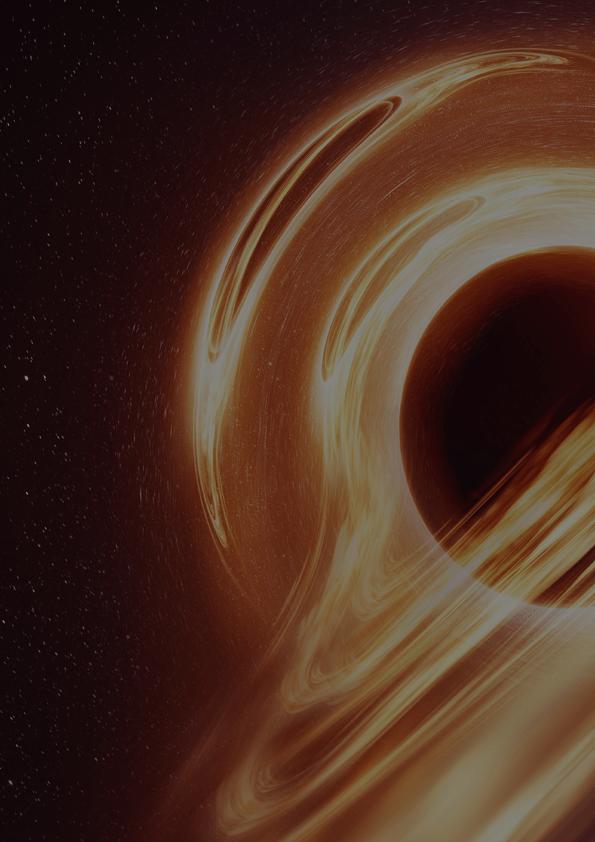
From this article, it sounds like we know quite a lot about black holes, but they are still one of the biggest mysteries in astronomy today. In fact, they have been puzzling scientists for hundreds of years and I suspect they will for hundreds more years. So, what don’t we know?
How small can black holes be? Can they be tiny?
They are in fact a predicted possibility, however, typically they would be incredibly difficult to observe. They would have a very small effect on the environment around them and they would most likely not live very long at all. In fact, there is some speculation there could be a tiny black hole somewhere in our solar system just outside the Kuiper Belt. However, that is a topic for another time.
How exactly do super-massive black holes exist?
From all we know about black holes the only way to create them is through the collapse of stars. These super-massive ones however have too much mass to be created by this method alone. There is an idea that they form when galaxies collide, but even then, they cannot explain how exactly those black holes got so big.
How many black holes are there in the universe?
Scientists have used direct mathematical equations and come up with that black holes are estimated to make up 1% of the universe’s matter. Through this, they have estimated that there are around 40 quintillion or 40,000,000,000,000,000,000 stellar black holes that populate the observable universe. This does not equate to supermassive black holes or tiny ones that might or might not exist. So, in essence, a lot.

Discover the secrets of the universe and the rich history of Perth Observatory on our Sunday guided day tours!
Nestled in the stunning bush settings of Bickley, our Observatory is the perfect place to explore the wonders of the cosmos.
Our knowledgeable guides will take you on a journey through time, from the Observatory’s humble beginnings in 1896 to its move to Bickley in 1966 and beyond. You’ll get to tour the Meridian, Astrograph & Calver Telescopes, learn about timekeeping, and explore the museum to discover fascinating stories about the Observatory’s past and present.
I the weather permits, you’ll have the opportunity to safely observe the Sun and its sunspots. It’s an experience you won’t want to miss!
There is no need to book, simply come up between 1 and 4 pm and pay in our shop. Our Sunday day tours are the perfect way to spend a relaxing afternoon with family and friends, surrounded by the beauty of nature and the mysteries of the universe.

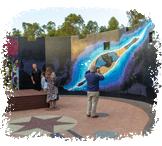
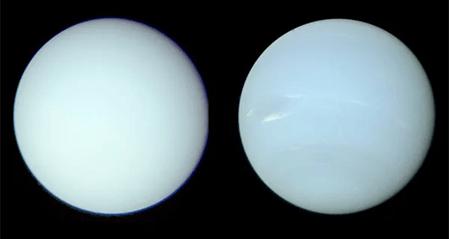
In the summer of 1989, NASA’s Voyager 2 spacecraft ventured to the outer edges of our solar system, offering humanity its first close-up glimpses of Neptune. These initial images unveiled a mesmerising sight: a profound, azure world. Yet, neighbouring Uranus, the celestial sibling discovered earlier through telescopic observation, presented a less captivating, pale cyan hue.
This striking contrast puzzled many, given the similarities between these twin ice giants—they share comparable sizes and atmospheric compositions rich in hydrogen, methane, and ammonia. However, recent research led by UK astronomers from the University of Oxford has uncovered a surprising revelation: both Neptune and Uranus don hues
of greenish-blue, contrary to previous assumptions.
The Voyager 2 mission, while providing invaluable data, inadvertently skewed perceptions of Neptune’s true colour. Though the spacecraft’s images of Uranus were presented closer to their natural hues, those of Neptune underwent alterations to emphasize atmospheric features. This enhancement, akin to Instagram filters, artificially intensified Neptune’s blue tint, deviating from its actual appearance, which closely resembles that of Uranus. This artistic rendering likely stemmed from a desire to compensate for the initial disappointment surrounding Uranus’s hazy upper atmosphere, which hindered the observation of distinct atmospheric phenomena.

Although planetary scientists were aware of this colour manipulation at the time, subsequent interpretations and public perceptions gradually veered off course. Professor Irwin and his team revisited the original Voyager 2 image data, endeavouring to rectify this misrepresentation. Their meticulous processing yielded what is touted as the most precise depiction to date of both Neptune and Uranus’s true colours.
The misinterpretation arose from the recombination of images captured in three separate colours by Voyager 2, often resulting in unbalanced composite images. Additionally, aggressive contrast enhancements aimed at delineating cloud formations and atmospheric dynamics inadvertently amplified Neptune’s blue hue beyond reality. In their recent study, researchers leveraged data from advanced instruments like the Hubble Space Telescope’s Imaging Spectrograph and the Multi Unit Spectroscopic Explorer on the European Southern Observatory’s Very Large Telescope. These instruments provided continuous spectra of colours for each pixel, facilitating the accurate determination of the planets’ true colours. The analysis unveiled that both Uranus and Neptune exhibit a similar shade of greenish-blue, albeit with subtle distinctions.
Neptune displays a faint hint of additional blue, attributed to a thinner haze layer compared to Uranus. Moreover, Uranus’s colour appears greener during its summer and winter, when its poles face the Sun, while it adopts a bluer hue during spring and autumn when the Sun aligns with its equator.
In showing the true colours of Neptune and Uranus, it serves as a poignant reminder of the ever-evolving nature of scientific understanding and the importance of revisiting past data with fresh perspectives and advanced technologies. As humanity continues its journey of cosmic discovery, such revelations illuminate the depths of our celestial neighbours, enriching our appreciation of the vast wonders that lie beyond our home planet.

Synopsis:
Ryan Reynolds stars as a pilot who crash lands in 2022 and meets his nerdy 12-year-old self. They then need to team up to save the future.
Review:
Ryan Reynolds is a busy man. In the 30 years since his first movie at 17 years of age, he’s shown the world that he’s not just a pretty face with a quick wit but that he’s also incredibly versatile and can play a wide variety of roles. He’s racked up at least 64 movies, with possibly one of his most famous roles being the “R” rated Deadpool. He also co-owns Wrexham Football Club in Wales, is an investor in Canadian startup Wealthsimple, is married to the beautiful and talented Blake Lively and Dad to four children.
So how did this former Sexiest Man Alive get time to film “The Adam Project”? Time Travel?
This is a kid-friendly movie, it’s a beautiful story of broken families that make good. There are lots of funny and emotional bits, exciting action, great SFX and the young Walter Scobell is uncanny in his portrayal of young Adam (Ryan Reynolds). The chemistry between the actors is undeniable. Effortless performances from Jennifer Garner, Mark Ruffalo and Zoe Saldana help this movie soar. I really loved this feel-good movie.
It was so easy to watch and made me feel like I was back in the 80s watching a Spielberg movie.


Director: Shawn Levy
Writer: Jonathan Tropper, T. S. Nowlin, Jennifer Flackett, and Mark Levin
Cast:
Ryan Reynolds, Mark Ruffalo, Jennifer Garner, Walker Scobell, Catherine Keener, and Zoe Saldaña
Awards:
Winner for a People’s Choice Awards for Comedy Movie of 2022
Nominee for a MTV Movie & TV Awards of 2022 for Best Movie
Nominee for a Dragon Awards of 2022 for Best Science Fiction or Fantasy Movie
Available On:
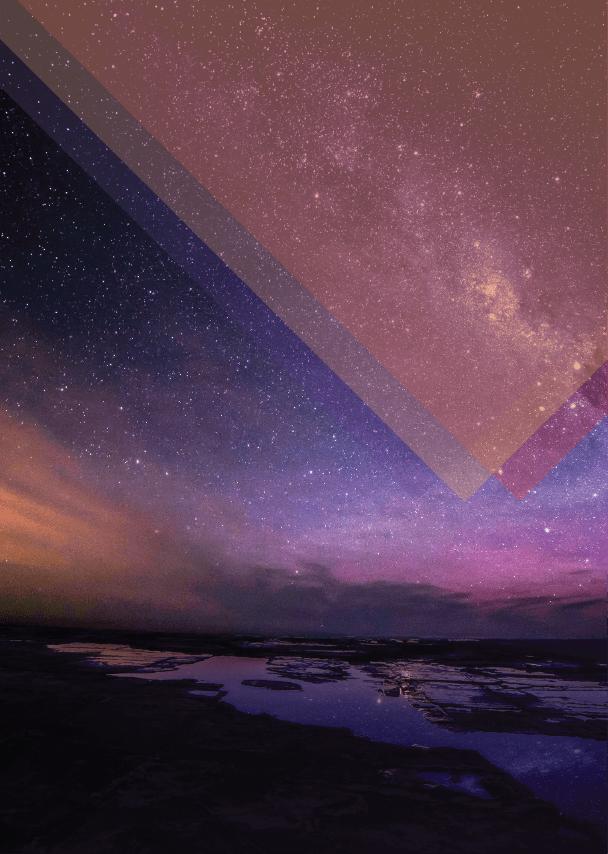
Looking for an unforgettable night under the stars? Look no further than Perth Observatory’s offsite astronomy nights! As Western Australia’s leading Observatory, our experienced volunteers are dedicated to sharing the beauty and wonder of the night sky with people across the state.
Our team will bring their top-of-the-line telescopes and expertise to your town, suburb, or school, providing you with a unique and immersive journey through the Southern Hemisphere’s celestial wonders. We will also guide you through the night sky with the help of our green lasers, teaching you about the stars, planets, nebulas, dying stars, and enormous star clusters that populate our universe.
Whether you are an astronomy enthusiast or simply looking for a fun and educational experience, our offsite astronomy nights are the perfect way to explore the beauty and complexity of our universe. Request your night under the stars below and discover the magic of Perth Observatory!
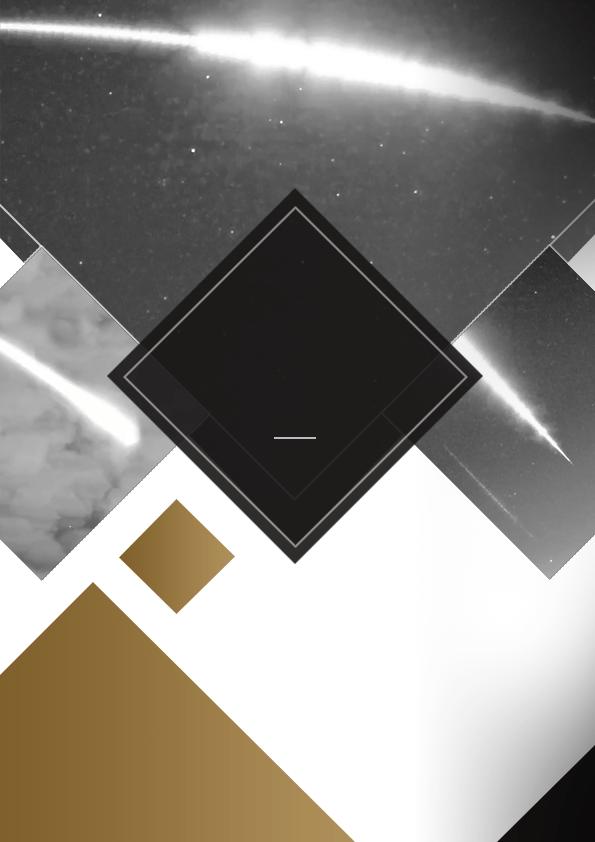
Perth Observatory is a member of the Global Meteor Network, and we now have seven cameras recording the night sky. These state-of-the-art cameras capture meteors, satellite passes, and other celestial events, providing us with a unique view of the Solar System’s formation and evolution.
The footage captured by these cameras is not only valuable for scientific research but also for public viewing. You can watch live images from the cameras at night, which update every three minutes during the night. Additionally, we’ve made available condensed footage from the previous night, highlighting every meteor detection. Be warned, it’s hard not to get hooked on watching these videos.


NGC 869 (Top) and NGC 884 (Bottom) make up the Double Cluster often designated h Persei and χ Persei in the constellation of Perseus. They also are listed in Patrick Moore’s list as Caldwell 14. They can be seen by the unaided eye from a dark sky location very low in the northern evening sky in Western Australia. Best seen in November and December, They have been described as being an “awe-inspiring” and a “breathtaking” sight.
I observed these two clusters at Griffith’s Observatory in California and had the good fortune to experience good viewing weather from up there on top of the hill close to that great big Hollywood sign!
NGC 869 is the open cluster on the left of the picture and was the object I had pleasure to view…it took my breath away and I was searching for a picture that would reflect what I saw through the telescope. This was it, so I contacted the owner Jerry and asked for permission to share this amazing open cluster with you the reader. To my eye it looked like this… the colour… honestly, I went back into the queue 3 times to get extra viewing. Now as this is a northern hemisphere constellation it might be a while before I get the chance again but any readers out there in the northern hemisphere go for it, you will not be disappointed!
Now let me give you some background:
Hipparchus, a Greek astronomer, is reputed to have catalogued the object (a patch of light in Perseus) as early as 130 B.C. However, the true nature of the Double Cluster wasn’t discovered until the invention of the telescope many centuries later. William Herschel was the first to recognize the object as two separate clusters in the early 19th century.
The Double Cluster is circumpolar (continuously above the horizon) from most northern temperate latitudes. It is close to the constellation Cassiopeia. At about 7,000 light years, the clusters are separated by only a couple of hundred light years in space.
The clusters are relatively young at 5.6 and 3.2 million years old respectively. (Sky Catalogue 2000). Both clusters are about 30 arc minutes in diameter and shine at magnitude 4.3 and 4.4.
Although easy to locate in the northern sky, observing the Double Cluster in its two parts requires optical aid. The Double Cluster is approximately the radiant of the Perseid meteor shower, which peaks annually in August.
NGC 869 has a mass of 3700 solar masses and NGC 884 weighs in at 2800 solar masses; however, later research has shown both clusters are surrounded by a very extensive halo of stars, with a total mass of the cluster of at least 20,000 solar masses. There are estimated to be more than 300 blue-white super-giant stars in each of the clusters. Their hottest main sequence stars are of spectral type B0. A truly spectacular sight!
Jerry Lodriguss is an accomplished astrophotographer and a contributing editor at Sky & Telescope.

Eratosthenes was born in 276 B.C. in the city of Cyrene which is in the modern-day country of Libya. He studied astronomy, geography, and math for a few years in Athens. Later, he studied and spent most of his adult life in Alexandria Egypt. He made some interesting and surprising discoveries in his lifetime.
Eratosthenes is famous for making the first good measurement of the size of the Earth. He did that sometime around 240 B.C. He observed that there was no shadow at the bottom of a well in a town called Syene in southern Egypt on the summer solstice. He worked out that the Sun must be straight overhead in Syene on that day. So, he measured the length of the shadow of a tall tower in Alexandria on the same day. He then had someone measure the distance between Alexandria and Syene and he used that distance, what he knew about the Sun’s angles and some geometry to figure out the size of the Earth.
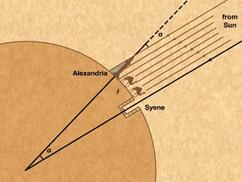
With this information, he was able to calculate the circumference of the Earth. His exact answer is unknown; because nobody knows the exact length of the distance units he used (called “stadia”). He may have gotten it right to within 1%, or he may have been off by about 16%. Either way, his answer was pretty good... and he was the first person to make a good measurement of the size of the Earth! He was also the first to calculate the tilt of the Earth’s axis (again with remarkable accuracy).
In ancient times, the Library of Alexandria was the most famous library in the world.
Eratosthenes was the second person to be head librarian there. During his time at the Library of Alexandria, Eratosthenes devised a calendar using his predictions about the ecliptic of the Earth. He calculated that there are 365 days in a year and that every fourth year there would be 366 days. Eratosthenes made several other important inventions and discoveries. He invented an easy method for finding prime numbers. That mathematical method is now called the Sieve of Eratosthenes He made a map of the “whole world”. Actually, the map only showed the parts of the world that the Greeks at the time knew about; but it was one of the best maps of its time.
Eratosthenes also invented a system of latitude and longitude.
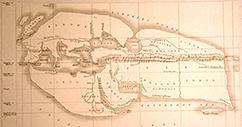
In fact, it is suggested that he was the father of geography. He described and mapped his entire known world, even dividing the Earth into five climate zones: two freezing zones around the pole, two temperate zones, and a zone encompassing the equator and the tropics. He had invented geography! He created terminology that is still used today. He placed grids of overlapping lines over the surface of the Earth. He used parallels and meridians to link together every place in the world.
He also is credited with inventing a mechanical device that astronomers used for many years to figure out where the stars were in the sky and how they appeared to move (as the Earth turns). That device was called the Armillary Sphere. Eratosthenes also made a catalogue of stars that had 675 stars listed in it. He died in Alexandria in 194 BC at the age of 82 years. Some people believe that Eratosthenes starved himself to death on purpose after going blind, he never married. A crater on the Moon is named after Eratosthenes.
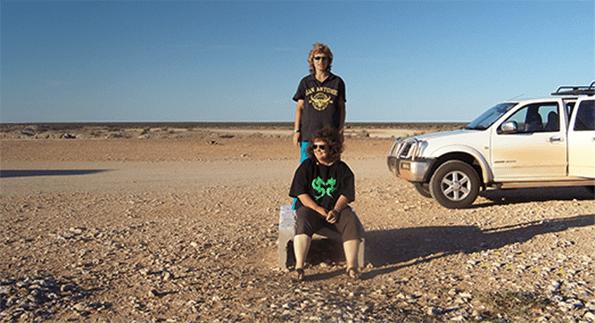
Have you met Jo and Sue? They are two amazing volunteers who help out in so many areas of the Observatory, you can always hear them when they arrive as the laughter wafts down the corridor as they stop for a chat, a few laughs and to help out with ideas or a shoulder to lean on.
JM: When did you both start at POVG?
J&S: We both joined in the September intake in 2016 and got straight into helping out wherever we could.
JM: Why did you join?
J&S: We wanted to learn more about space and stars and surround ourselves with intelligent people. (laughter). We became friends with a volunteer Telescope Operator, Elaine Walker, through a Scots Club, she told us about the Observatory, and we would come to all the Summer Lectures we came
along to them all before we joined. Then once we were volunteers, we used to help Tilly in the car park for them. Great Fun.
JM: What are your volunteer roles?
J&S: Gardening on Tuesdays, driving the Kubota around and stirring up Rob Kennedy in Maintenance. Jo is amazing on the Till in the Shop and we both have helped with shop displays; stock takes and sourcing of goods. We’ve worked in retail forever. Sue is training as an Amateur Astronomer as well. We both come up to Night Sky Tours to help. We do general duties as required, help with photography workshops, special events you name it.
JM: What do you do when you aren’t at the Observatory?
J&S: We’ve been buying and selling sell ornamental and tropical fish for the past 40
years; our business is called Living Pictures. But this month we’re retiring from the fish business - but not from life. Who knows what may come up?
JM: Do you have hobbies? What are they?
J&S: Archery (Jo is the best at archery), Bagpipes (Sue is amazing at this and her bagpipe band is in great demand), book binding, stamp collecting, gardening. We’re going to a Bagpipe competition in Melbourne on 15th April, so we need to find homes for our fish before then.
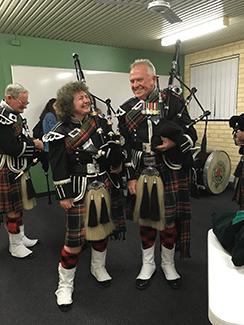
JM: What is your favourite part about being a volunteer at POVG?
J&S: Being around nice people. Most of the people are fantastic. Learning more about stars and planets and getting involved with the activities that the Observatory puts on which is lots of fun.
JM: Do you have a favourite memory of your past 8 years with the POVG?
J&S: Going to Supanova was really good fun, loved talking to people, getting involved, trying to flog stuff at the stall and stop people pinching stuff, and seeing the costumes. We love Astrofest and Summer Lecture.
JM: What’s your favourite sci/fantasy movie or book?
J&S: The Mandalorian, The Lord of the Rings, Game of Thrones. Star Trek Voyager. I like tongue-in-cheek stuff, a bit of fun (Jo) like Guardians of the Galaxy. I hate that movie (Sue).

JM: Any plans for the future?
J&S: Eat, drink and be merry. Travel. Enjoy. This year is going to have quite a bit of travel in it. We’re ready to try a new direction and try something new.
All the best to Jo and Sue as they get to enjoy their “retirement” from the fish business but as they said, not from life. I can’t wait to see what these dynamic women do next. See you up at the Observatory!
In May, celestial wonders adorn the early morning sky, inviting observers to witness the graceful dance of planets and stars. As dawn breaks, Mercury emerges in the eastern horizon, nestled amidst the constellations of Pisces (The Fish), and Cetus (The Sea Monster). As the month unfolds, Mercury’s celestial voyage through the sky leads it into the constellation of Taurus (The Bull), In the second week, Mercury reaches its greatest elongation in the western sky on Monday, May 10th, before retracing its path towards the radiant glow of the Sun.
Meanwhile, the radiant glow that is Venus is illuminating the eastern sky very low in the sky before dusk in the constellation of Aries (the Ram), at May’s inception. However, as the first week progresses, Venus will retreat into the Sun’s brilliance, bidding farewell to the early morning.
Mars, the fiery red wanderer, makes its presence known in the eastern heavens, nestled between the constellations of Pisces and Cetus during the early hours. Yet, as the month draws to a close, Mars shifts into the constellation of Pisces. Jupiter, obscured by the Sun’s brilliance, eludes the gaze of stargazers throughout May, hidden from view amidst the cosmic tapestry. Saturn rises around midnight amid the constellations of Aquarius, Pisces, and Cetus. On the 4th of May in the early morning the Moon will be super close with Saturn.
As May unfolds, Uranus emerges from the cloak of obscurity, rekindling its celestial journey in the early morning hours amidst the boundless expanse of Taurus, a welcome sight after its temporary disappearance in April. Lastly, Neptune, the distant blue jewel of the solar system, beckons in the early morning sky, weaving its ethereal presence between the timeless constellations of Pisces and Cetus, offering a serene and captivating vista of the nocturnal heavens.
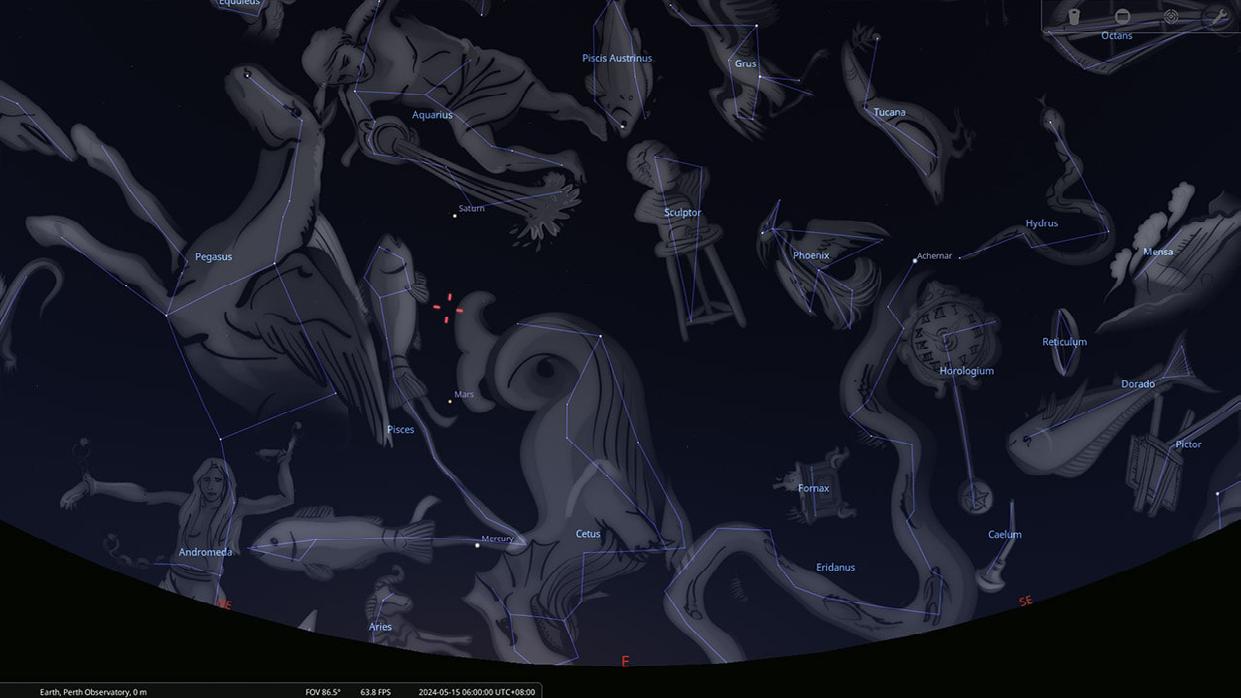
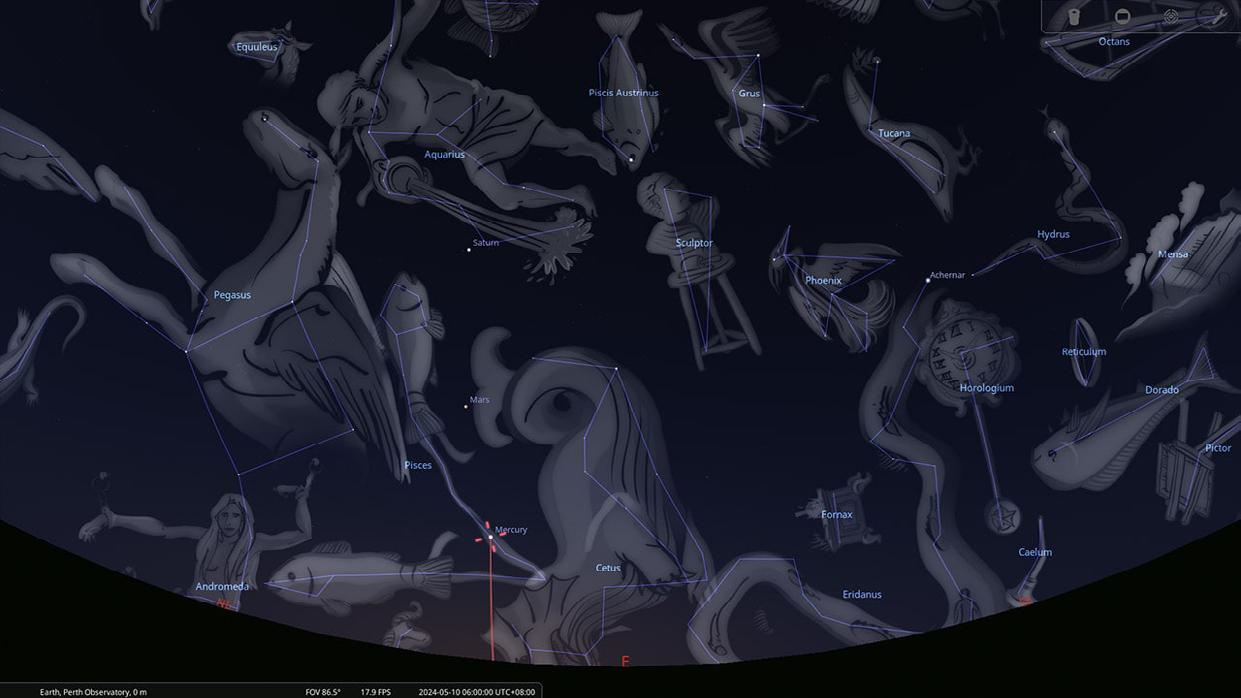
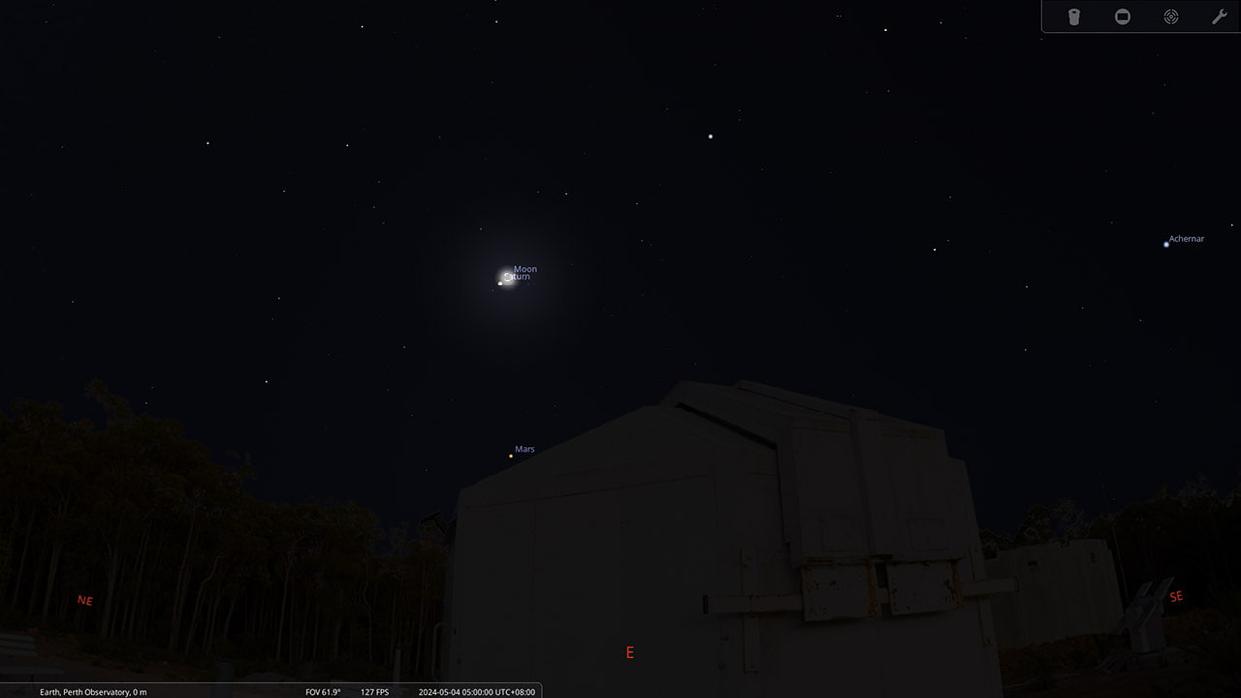
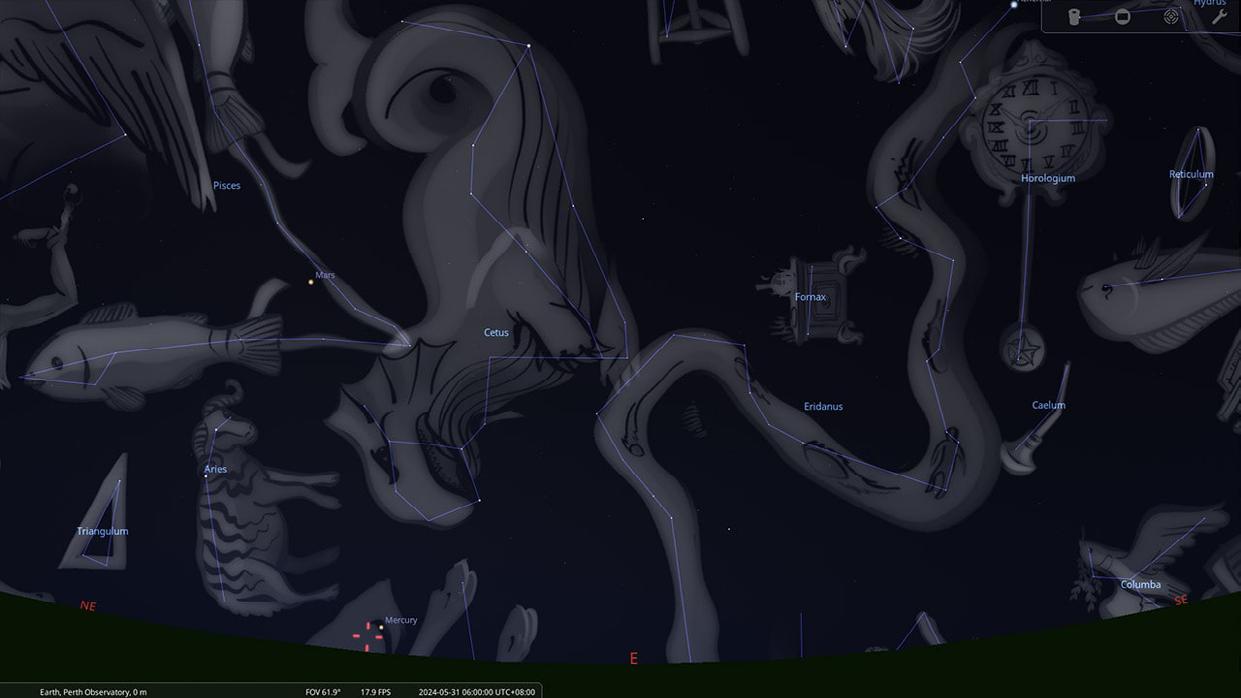
The Eta Aquarids Meteor Shower will reach its peak on the night of May 5th/6th, providing skywatchers with a chance to witness one of nature’s most impressive displays. This meteor shower is active from April 19th to May 28th and is caused by the famous Comet Halley. The Eta Aquarids are one of two meteor showers caused by this comet, with the other being the October Orionids.
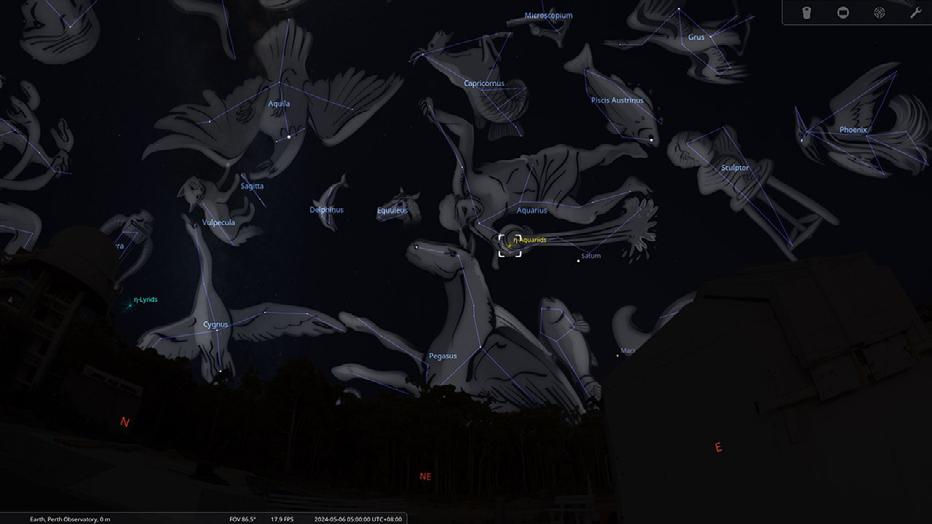
The meteors will seem to originate from the Aquarius constellation, giving the meteor shower its name. If you’re located in the Perth, Aquarius will appear in the sky at around 11:30 pm, and the best time to watch the meteor shower is around 4:00 am (AWST). This year there will be no Moon in the sky throughout the night, so there won’t be any light pollution from it. In dark sky locations, we should see up to 50 meteors per hour.
Southern Pleiades:

An open cluster, the Southern Pleiades (IC 2602) can be found very close in the constellation Carina and is named after the Pleiades Cluster due to their similarity. This cluster is one of the closest to us at 547 light-years away from Earth, and it contains about 60 stars. The cluster is believed to be 50 million years old and was discovered by French astronomer Abbé Nicolas-Louis de Lacaille in 1751 from South Africa.
They’re the third-brightest open cluster in the sky, following the Hyades and are 70% fainter than the Pleiades Cluster the brightest Cluster. Like its northern counterpart, the Southern Pleiades is best viewed with large binoculars or telescopes with a wide-angle eyepiece.

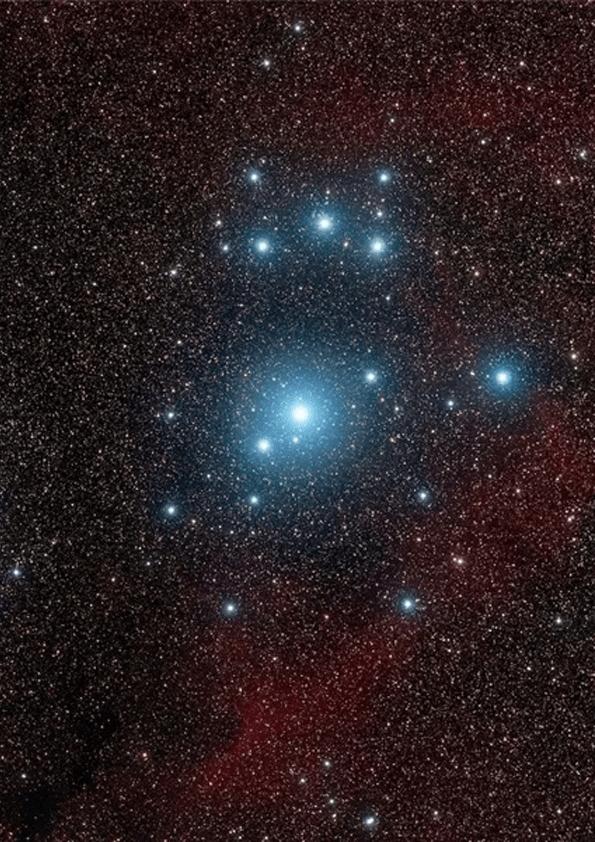
In June, Mercury starts off in the Taurus constellation but quickly vanishes behind the brightness of the Sun. Towards the end of June, it pops back up in the evening sky between the constellations of Gemini (The Twins) and Cancer (The Crab). Venus is still in the Sun’s glare, so we won’t be able to see it in June. Mars starts June in the constellation of Pisces (The Fish) and then moves over to the constellation of Aries (The Ram) as June progresses.
Jupiter is hiding in the glare of the Sun early in June but shows up later in the month in the evening sky, hanging out in the constellation of Taurus (The Bull). on the 4th and 5th of June, Mercury and Jupiter will be Super close in the morning sky round 6:30 am. Saturn can be found between the constellations of Aquarius, Cetus, and Pisces throughout June around midnight.
Uranus, the icy giant, stays put in the constellation of Taurus throughout the month of June. Lastly, Neptune, the distant blue jewel of the solar system, can be spotted between the constellations of Pisces, and Cetus during June.
Earth At Perihelion:
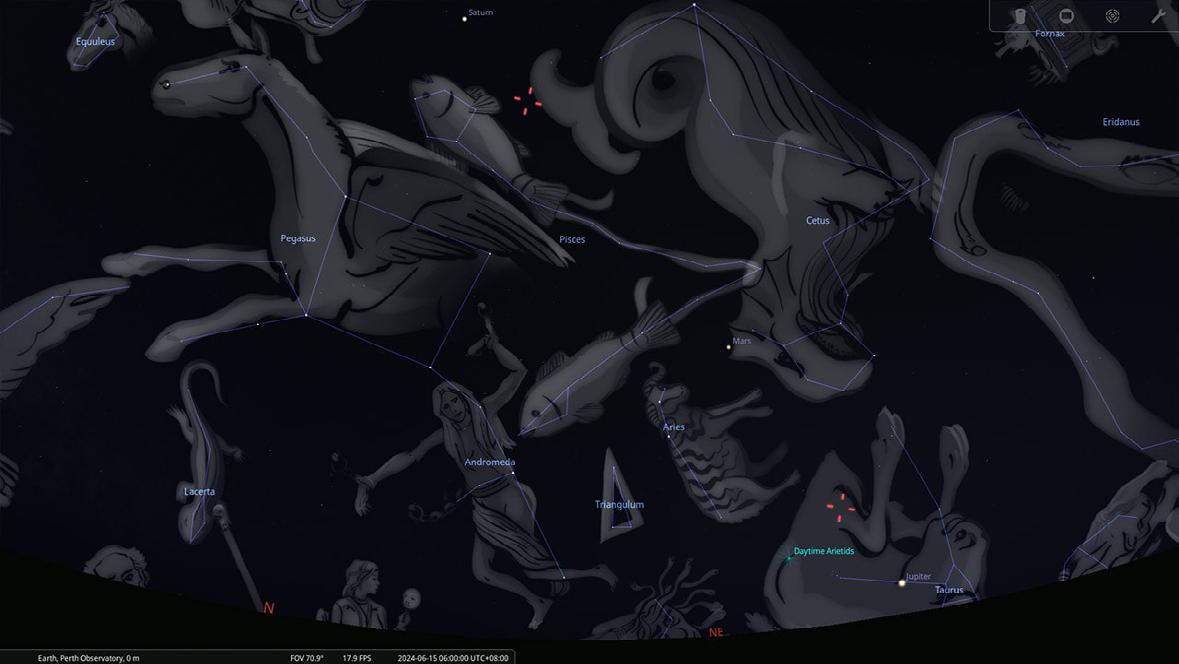

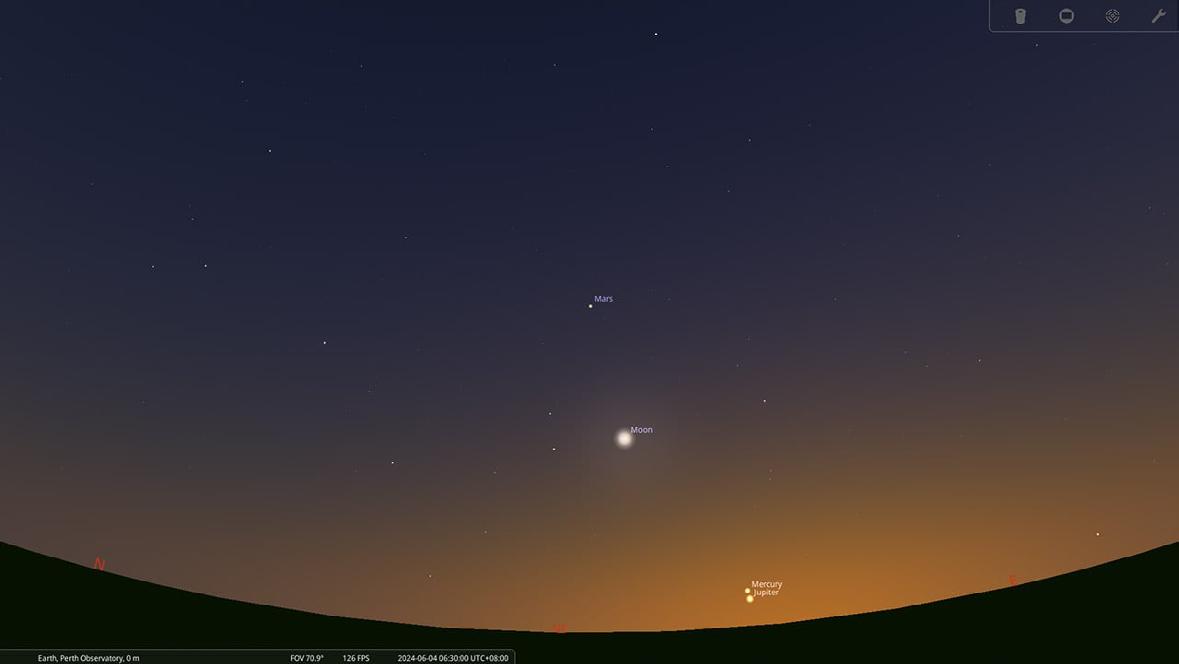
The June Solstice marks an astronomical event that occurs twice a year, with the next one taking place on Friday the 21st of June at 10:57 pm (AWST). It signifies the beginning of winter in the southern hemisphere and the start of summer in the northern hemisphere. This event happens when the Sun’s declination equals 23.5 degrees south as observed from Earth. The Tropic of Cancer is the line of latitude where the Sun passes directly overhead during the June solstice, although in modern times, the Sun is in the astronomical constellation of Gemini in mid-June due to precession.
During the June solstice, the southern rotational pole of the Earth is tilted away from the Sun, initiating its long apparent journey northward until December. The wobbling of Earth’s axis, known as the Precession of the Equinoxes, takes about 26,000 years to complete one full cycle. This means that over the average lifespan of 72 years, the equinoctial points would have moved one degree, which is approximately twice the diameter of a full Moon.
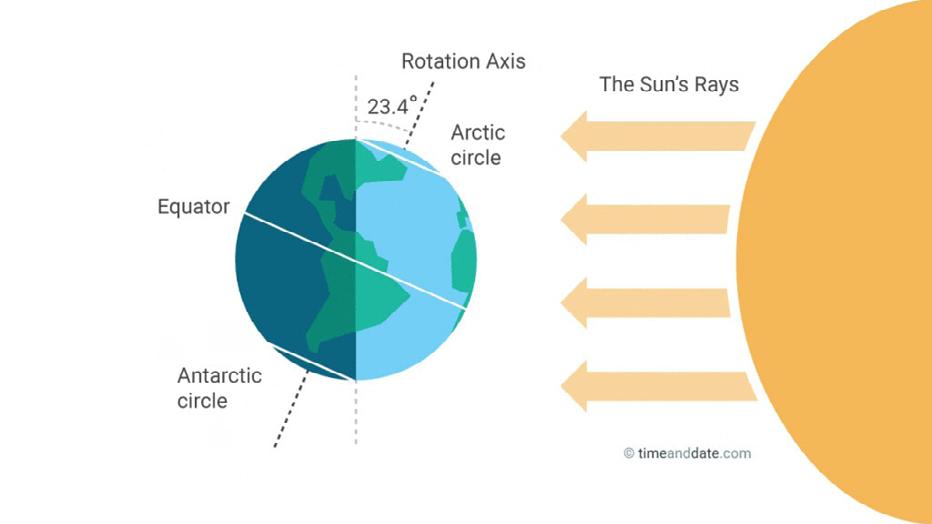
Many cultures celebrate the June solstice with festivals and traditions, including the ancient Druids who celebrated it as the “Alban Heruin” or “light of the shore.”
Omega Nebula:
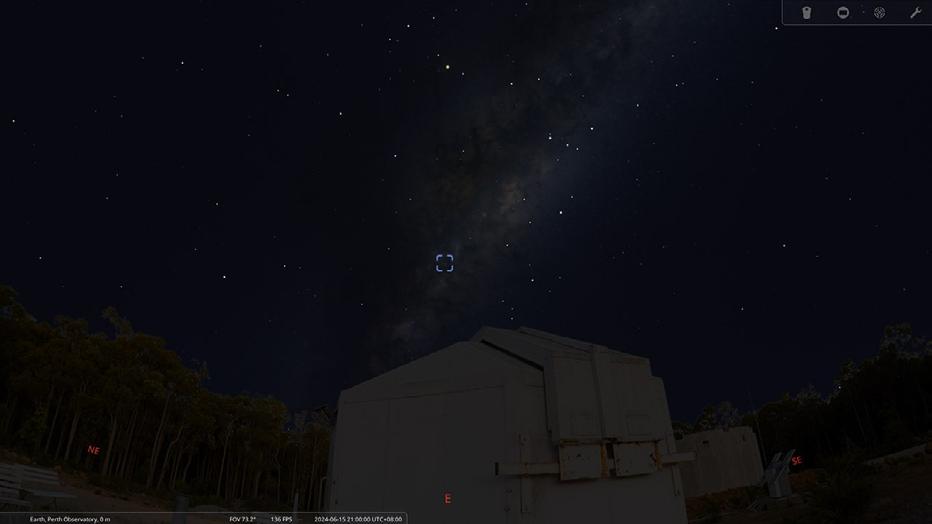
The Omega Nebula, also known as Messier 17, is a beautiful emission nebula located in the constellation Sagittarius. It’s located approximately 5,500 light years away from Earth and spans a distance of about 15 light years. It is an active region of star formation and contains a large number of young, hot stars. These stars ionize the surrounding gas, causing it to glow with a beautiful pinkish-red colour.
The nebula is divided into several different sections. The central region of the Omega Nebula contains a cluster of stars that are responsible for illuminating the gas and dust in the nebula. The surrounding gas and dust have been shaped by the intense radiation and stellar winds from these stars, creating a beautiful and intricate pattern of filaments and pillars. Observing the Omega Nebula requires a telescope or a pair of binoculars, as it is a relatively faint object.
The nebula was discovered in 1745 and recorded by Charles Messier in 1764, and it’s so named because it appears like the Greek letter Omega. It may also be seen as a horseshoe with a “tail” to one side giving it, perhaps, a swan’s neck appearance. It’s also referred to as the Swan Nebula.
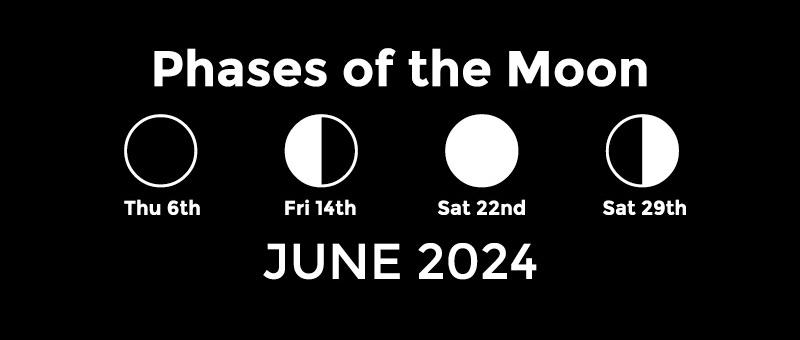
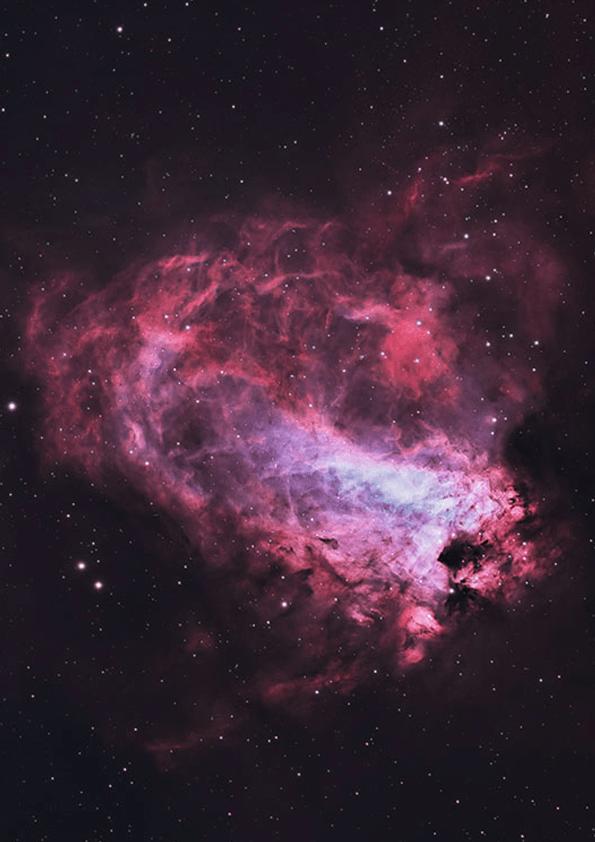


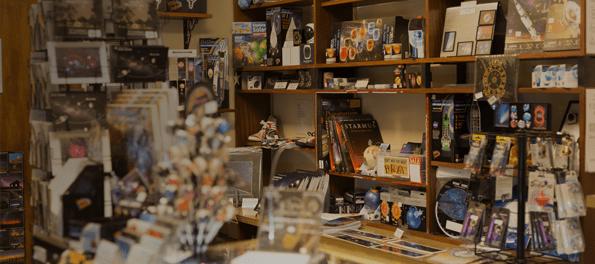




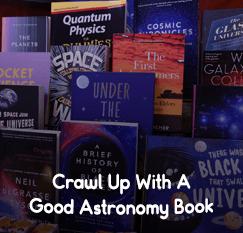
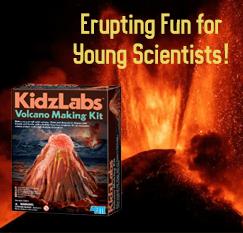


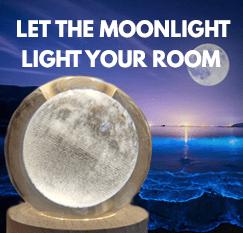
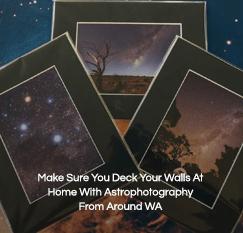
Help Perth Observatory through the Containers for Change scheme.
Please take glass, plastic, aluminium, steel, and paper-based cartons between 150ml and 3L to your local refund depot and use the Perth Observatory (Scheme ID: C10424615).
The Perth Observatory Volunteer Group will receive 10 cents for each container. Save the ID on your phone for every time you recycle your containers. Find your local refund depot and get more info on what containers are eligible for refunds here:
Can’t get to a refund centre? We have a dedicated and labelled bin on-site for you to add your clean container donations when you next visit the observatory.
Our maintenance volunteers collect donated containers and take them to the refund centre.
Thank you for helping the POVG promote sustainable and environmentally conscious practices and diversifying ways for us to raise much-needed funds.
Your help supports the continuing upkeep and running of Western Australia’s oldest observatory!



